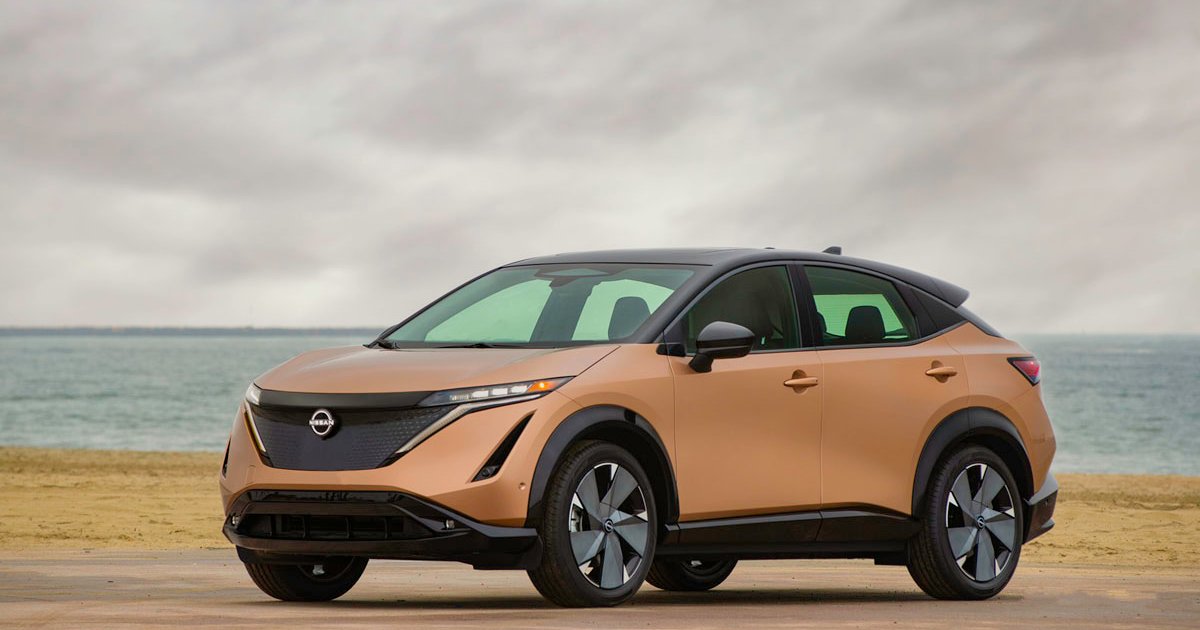
When Nissan’s long-awaited second all-electric model, the Ariya, rolls into stores by early next month, it will have to do so without the federal support that has powered EV adoption in the U.S. for more than a decade.
The Inflation Reduction Act alters the eligibility rules for a long-standing $7,500 EV tax credit. Designed to incentivize domestic EV production and reduce reliance on foreign supply chains, automakers must now assemble EVs and plug-in hybrids in North America to qualify for the credit.
That means the Japan-made Ariya won’t be eligible for the federal incentive, potentially putting its starting price of $44,485 at a competitive disadvantage.
Aditya Jairaj, Nissan’s director of U.S. EV marketing and sales strategy, said the loss of the credit is unlikely to have a near-term effect on sales as few vehicles on the market now qualify under the new rules.
“But there are some changes or adjustments we need to look at in the longer term,” Jairaj said. “We’re looking at how those could be expedited … so our relative competitiveness remains strong.”
One of those adjustments could involve shifting some Ariya production to the U.S. Some automakers, including Nissan’s rival Hyundai Motor Group, are considering accelerating plans to move EV assembly and battery production stateside to qualify for the credit.
Nissan, like its competitors, has announced plans to pivot more of its existing U.S. factory capacity to next-generation EVs. The Japanese automaker is making an $18 billion bet on electrification, vowing to deliver 15 battery-electric models globally by 2030. That figure involves a $500 million investment at Nissan’s underutilized truck plant in Canton, Miss., to build two EV models starting in 2025.
Auto analyst Sam Fiorani said North American production of EVs will become necessary for automakers to stay competitive and qualify for the tax credit.
“Moving production of any imported EV stateside increases the profitability for the manufacturer by thousands of dollars,” said Fiorani, vice president at AutoForecast Solutions.
But Jairaj demurred on the possibility of a Canton-built Ariya.
“Everything is on the table,” he said. “We’ve got to evaluate because there are different [eligibility] requirements. It’s not just for production.”
For Nissan, much is riding on the Ariya.
The automaker pioneered the EV market with the launch of the Leaf more than a decade ago. But it failed to capitalize on its early mover advantage, and the then-underpowered hatchback was outmaneuvered by better-performing and sleeker EVs.
Nissan is now launching a more contemporary and capable electric model for its second act.
The dual-motor Ariya, which competes with the Volkswagen ID4, Ford Mustang Mach-E and Tesla Model Y, positions Nissan in the market’s new sweet spot. According to data from Experian, EV light-truck registrations were up 63 percent through the first seven months of the year.
Jairaj described the Ariya as “the stepping stone to the next phase of electrification for Nissan to be very successful.”
The five-passenger family hauler is propelled by one of two batteries: a 63-kilowatt-hour pack or a larger 87-kWh unit. The driving range tops out at 304 miles.
The Ariya debuts an all-electric, all-wheel-drive system and Nissan’s next-generation ProPILOT Assist 2.0 automated driving software. The all-wheel-drive Ariya Platinum+ version delivers 389 hp — a 151-hp increase over the front-wheel-drive variants.
To widen its market appeal, Nissan was careful about being too radical with the design or user interface.
Jairaj said the Ariya makes the transition from internal combustion engines to EVs “smooth” for customers.
“The nonbelievers need to be very comfortable the moment they start driving an EV,” he said. “This is important as [the industry goes] beyond the 5 percent EV penetration we have today.”
To keep things familiar, Nissan hasn’t entirely ditched physical buttons — two switches flank a knobby volume control dial. Haptic buttons that sit flush with the dashboard control temperature, defrost and other functions.
“When you sit inside the Ariya, you don’t feel like you are sitting in a spaceship,” Jairaj said in a dig at Tesla’s spartan all-digital interior.
Nissan also upped the Ariya’s crossover creds with its “e-4ORCE” all-wheel-drive technology, which arrives in the U.S. early next year. The automaker said the system delivers high-torque precision handling and stability by optimizing power delivery to each of the four wheels.
“The Ariya is a crossover that happens to be an EV,” Jairaj said.
Nissan launched a reservation program late last year to drum up interest in the new model.
Jairaj declined to disclose the number of reservations, but according to an update shared with Nissan retailers before the program began, the Ariya had garnered about 135,000 hand raises from potential customers.
The reservation program is a way to connect with the product’s most enthusiastic customers, Jairaj said at the time.
“It’s a two-way dialogue,” he said. “Customers are extremely keen to understand how the Ariya can fit into their lives. We want to know about them, what their interests are, what they’re looking for.”
This summer, Nissan took the Ariya on a 15-city tour to familiarize would-be buyers with the crossover and its technologies.
“We’ve set the foundation for this model,” Jairaj said. “The interest is strong; the expectations also are pretty strong.”